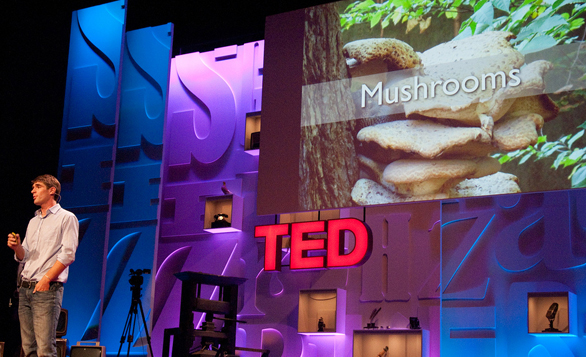
Product designer Eben Bayer is just one speaker who has shared an idea for how mushrooms can save the world on the TED stage.
In today’s TED Talk, biologist Mohamed Hijri directs our attention to an incredible biotechnology — not one he invented, but one that’s been around for 450 million years. They are: mycorrhiza, microscopic mushrooms that grow in a symbiotic relationship with the roots of plants. These mushrooms are incredible at helping plants find phosphorous, an essential element in the soil required for growth.
 Mohamed Hijri: A simple solution to the coming phosphorus crisis
Perhaps this doesn’t sound world-altering. But as Hijri explains, it is. Modern agriculture uses fertilizer pumped full of phosphorus in order to grow enough food — and yet crops are only able to absorb about 15% of this phosphorus through their roots. (The rest disappears into the soil.) And yet, we are quickly running out of this nutrient — we’ll reach peak phosphorus in 2030 and, by the end of the century, it will be all gone. This depletion is happening even as the global population is rising, meaning that as phosphorus is needed more than ever to meet food demands, we simply won’t have much left.
Mohamed Hijri: A simple solution to the coming phosphorus crisis
Perhaps this doesn’t sound world-altering. But as Hijri explains, it is. Modern agriculture uses fertilizer pumped full of phosphorus in order to grow enough food — and yet crops are only able to absorb about 15% of this phosphorus through their roots. (The rest disappears into the soil.) And yet, we are quickly running out of this nutrient — we’ll reach peak phosphorus in 2030 and, by the end of the century, it will be all gone. This depletion is happening even as the global population is rising, meaning that as phosphorus is needed more than ever to meet food demands, we simply won’t have much left.
This is why mycorrhiza are so important. If crops are grown with these teensy, tiny mushrooms, their roots are much better able to absorb phosphorus. If fact, says Hijri, we can use a quarter of the phosphorous in fertilizer, and get an even better growth result than we see today. We can greatly slow down our use of phosphorus to save for future generations. And a big bonus: runoff phosphorus won’t feed blue algae in the water supply.
 Paul Stamets: 6 ways mushrooms can save the world
Mycorrhiza could transform modern agriculture and stave off a crisis which, as Hijri puts it, no one is talking about. But that is really just the beginning of what mushrooms can do.
Paul Stamets: 6 ways mushrooms can save the world
Mycorrhiza could transform modern agriculture and stave off a crisis which, as Hijri puts it, no one is talking about. But that is really just the beginning of what mushrooms can do.
Paul Stamets has filed 22 patents for mushroom-related technologies and, in this talk from TED2008, he shares six ways that mycelium fungus — i.e. “the magicians” that form a complicated web of connections that hold soil together — could save the world.
- They can clean polluted soil. In this talk, Stamets describes an experiment where he put storm-blown mycelium in burlap sacks, and placed them downstream from a factory producing E-Coli. In 48 hours, the mushrooms reduced the amount of coliform bacteria in the soil 10,000 times. He shows how similar mushroom technology could also clean oil, and restore habitats near polluting factories.
. - They treat smallpox. Stamets and his team have identified three different strains of Agarikon mushrooms which are highly active against poxviruses.
. - And they can also cure the flu. Based on the results of Agarikon mushrooms against pox, Stamets and his team tested if they would be active against flu A viruses and flu B viruses. They were found to work very well.
. - They can be used to kill insects. Stamets shows how a non-sporulating form of mushroom can attracts bugs like carpenter ants, and then kill them. But even better, after sporulation, these substances can repel bugs, even termites, making a home unsuitable for infestation. Extracts can even steer bug movement.
. - They can turn cardboard boxes into forests. Toward the end of his talk, Stamets introduces us to the “Life Box,” cardboard which is made with mycorrhizal and endophytic fungi as well as spores. Add soil, tree seeds and water … and you can grow a forest.
. - And finally, they could be used to make fuel. Mushrooms could even, potentially, help address the energy crisis, since mycelium can convert cellulose into fungal sugars. A fascinating idea: mycelium-based ethanol.
It’s not just biologists touting the incredible potential of mushrooms. In this talk from TEDGlobal 2011, artist Jae Rhim Lee shares her mushroom burial suit.
 Jae Rhim Lee: My mushroom burial suit
A TED Fellow, she created this suit not just because it looks cool, but because our bodies are storehouses of environmental toxins — especially in death, when we are covered with fillers and cosmetics and pumped full of formaldehyde. The suit could reverse that damage. Embedded with spores of her in-development “Infinity Mushrooms,” Lee hopes the suit will prove capable of gobbling up toxins in the body and speeding up decomposition. “I believe this is the beginning of true environmental responsibility,” she says.
Jae Rhim Lee: My mushroom burial suit
A TED Fellow, she created this suit not just because it looks cool, but because our bodies are storehouses of environmental toxins — especially in death, when we are covered with fillers and cosmetics and pumped full of formaldehyde. The suit could reverse that damage. Embedded with spores of her in-development “Infinity Mushrooms,” Lee hopes the suit will prove capable of gobbling up toxins in the body and speeding up decomposition. “I believe this is the beginning of true environmental responsibility,” she says.
And finally, product designer Eben Bayer explains how mushrooms could potentially curb our reliance on plastics. In this talk from TEDGlobal 2010, he shares how and his team are creating a new class of material out of mycelium that could be used instead of Styrofoam.
 Eben Bayer: Are mushrooms the new plastic?
“When a tree’s done using it leaves … it’s doesn’t pack them up, take them to the leaf reprocessing center and have them melted down to form new leaves. It just drops them, the shortest distance possible to the forest floor, where they’re actually upcycled into next year’s topsoil,” he says. “In nature, mushrooms are the recycling system.”
Eben Bayer: Are mushrooms the new plastic?
“When a tree’s done using it leaves … it’s doesn’t pack them up, take them to the leaf reprocessing center and have them melted down to form new leaves. It just drops them, the shortest distance possible to the forest floor, where they’re actually upcycled into next year’s topsoil,” he says. “In nature, mushrooms are the recycling system.”
Warding off a phosphorus crisis, cleaning polluted soil, curbing smallpox and the flu, providing environmentally-friendly extermination, growing new forests, developing alternate fuel, revolutionizing the funeral industry and replacing throw-out plastics? Yep, that’s a whole lot of potential good that could grow out of mushrooms.
Comments (5)
Pingback: What’s So Magic About Mushrooms? – Timothy Tol – My thoughts, insights, musings and epiphanies